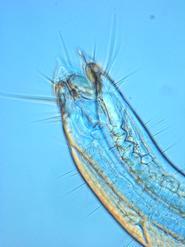
Visiting Assistant Professor of Biology Ashleigh Smythe gave an invited talk titled “Molecular Phylogeny of Enoplia: Implications for Classification and Stoma Evolution” at the 50th anniversary meeting of the Society of Nematologists held July 17-20 at Oregon State University in Corvallis, Ore. Her talk was presented in the symposium “Freshwater and Marine Nematodes.”
Smythe’s presentation focused on her study of the evolutionary relationships and morphological evolution of a group of marine nematodes called Enoplia. According to Smythe, Enoplid nematodes are evolutionarily important as they may represent the earliest lineage of all nematodes, and understanding their evolution improves our understanding of the entire phylum, including important human, animal and plant parasites. Enoplids also display a wide variety of morphological features of the mouth region, including adaptations for predatory, algal and bacterial feeding, and Smythe’s work aims to understand the evolution of these morphologies.
According to the conference program, the Society of Nematologists was founded in 1961 and is “an international organization formed to advance the science of nematology in both its fundamental and economic aspects.”
